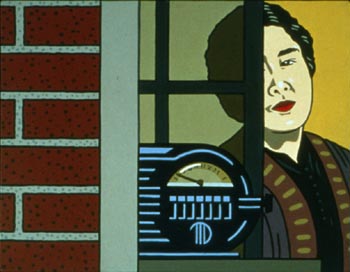![[Metroactive Arts]](/arts/gifs/art468.gif)
[ Arts Index | San Jose | Metroactive Central | Archives ]
Woodblock Diary
Roger Shimomura remembers the internment in 'An American Diary' at the San Jose Museum of Art
By Ann Elliott Sherman
AS UNDERSTATED and self-contained as the diary that inspired it, Roger Shimomura's An American Diary, at the San Jose Museum of Art, is the artist's latest visual translation of his grandmother's written chronicle of her family's incarceration during World War II. Unlike the 30 small paintings here, accompanied by excerpts that present the actual protagonists in their '40s attire, Shimomura's previous work based on the diary used kimono-clad stand-ins appropriated from Ukiyo-e woodblock prints.
As Shimomura explains, the more straightforward, comic-book look of the American Diary paintings allows the real subject of the works to be the internment, rather than layering in the topic as subtext for an aesthetic style. The comics approach also lends its own readymade ironic subtext: the genre originating in male empowerment fantasies of young Jewish immigrants here displays the stripping of Japanese American immigrants' basic rights.
Still, the series' strategy allows Shimomura to stay comfortably within the realm of recognized fine arts, calling to mind the work of Roy Lichtenstein. If, as the exhibition's introductory wall text states, the touring show is intended to educate the public about the realities of the internment, one wonders why Shimomura didn't go a step further and issue the work in a truly accessible format--say, an actual comic or graphic novel.
Perhaps the comparisons with Lichtenstein's style are preferred over a more direct comparison with Art Spiegelman's Maus, or maybe the artist just didn't want to wander too far afield from his usual mode of expression in creating what is simultaneously a most private, personal history and an overlooked matter of public record.
Other dichotomies abound in the paintings. The April 21, 1942, illustration splits the canvas between an idyllic Seattle view of snowy mountains rising behind little sailboats on the water and a copy of Executive Order 9066 taped to a brick wall.
Shimomura's response to his grandmother's poignant entry on the one-year anniversary of the war's outbreak, "Those of us that share the virtues of both countries pray for the earliest possible peace," contrasts a bowl of tofu and udon with a Baby Ruth, cut to resemble sushi.
ALTHOUGH HE USES the smooth, punchy graphics and small panels of comics, Shimomura principally keeps to the subtle, grayed shades of wood-block prints. Early in the series, primary colors are reserved for comic-book heroes deployed as Shimomura's editorial comments on his grandmother Toku's less-than-militant response to the United States government's actions against its own citizens.
In her Dec. 12, 1941, entry, Toku recounts: "We were permitted to withdraw up to $100 from the bank. This was for our sustenance of life, we who are enemy to them. I deeply appreciated Americans' large heartedness in dealing with us." Shimomura's "yeah, right" response is an illustration of Superman alighting out of the sky, his head cropped out of the frame, a faceless flex of power wrapped in red and blue.
For Toku's entry about registering her fingerprints, the artist shows his grandmother as a silhouette darkening the door of none other than Dick Tracy in his trademark yellow fedora. By using these popular icons as stand-ins for the government, Shimomura underscores both the perceived and real distance between the interned and their fellow Americans.
Later, once the narrative has relocated along with his family, the occasional bursts of clear color--a red birthday balloon or yellow Halloween mask--jolt eyes grown used to a restricted, muddy palette, the visual equivalent of the singular, vivid detail that separates a potent, personal memory from the daily monotony of the camp in the relentless, southern Idaho terrain.
The confinement of internment is made palpable by Shimomura's compositions. The wide and cloudless desert sky is glimpsed only through a window or cracked door, and even then, it serves only as backdrop for barbed wire. The "landscape" of the camp is the amber grain of raw plywood, tar paper and nails. Our most direct view of anything natural is not the usual landscape perspective of one exalted by grandeur, but rather that of people who must watch where they step in deep and rutted muck.
Shimomura's paintings operate like a family photo album professionally edited into a documentary. Perhaps An American Diary's greatest accomplishment is that after seeing the movie, I'd like to read Toku's book.
[ San Jose | Metroactive Central | Archives ]
Copyright © 2000 Metro Publishing Inc. Metroactive is affiliated with the Boulevards Network.
For more information about the San Jose/Silicon Valley area, visit sanjose.com.
![]()

Serial Comics: Artist Roger Shimomura created 30 paintings done in a comic-book style to illustrate his grandmother's diary about the family's imprisonment in an internment camp.
An American Diary: Paintings and Prints by Roger Shimomura runs through Jan. 7, 2001, at the San Jose Museum of Art, 110 S. Market St. (408.924.4328)
From the November 30-December 6, 2000 issue of Metro, Silicon Valley's Weekly Newspaper.